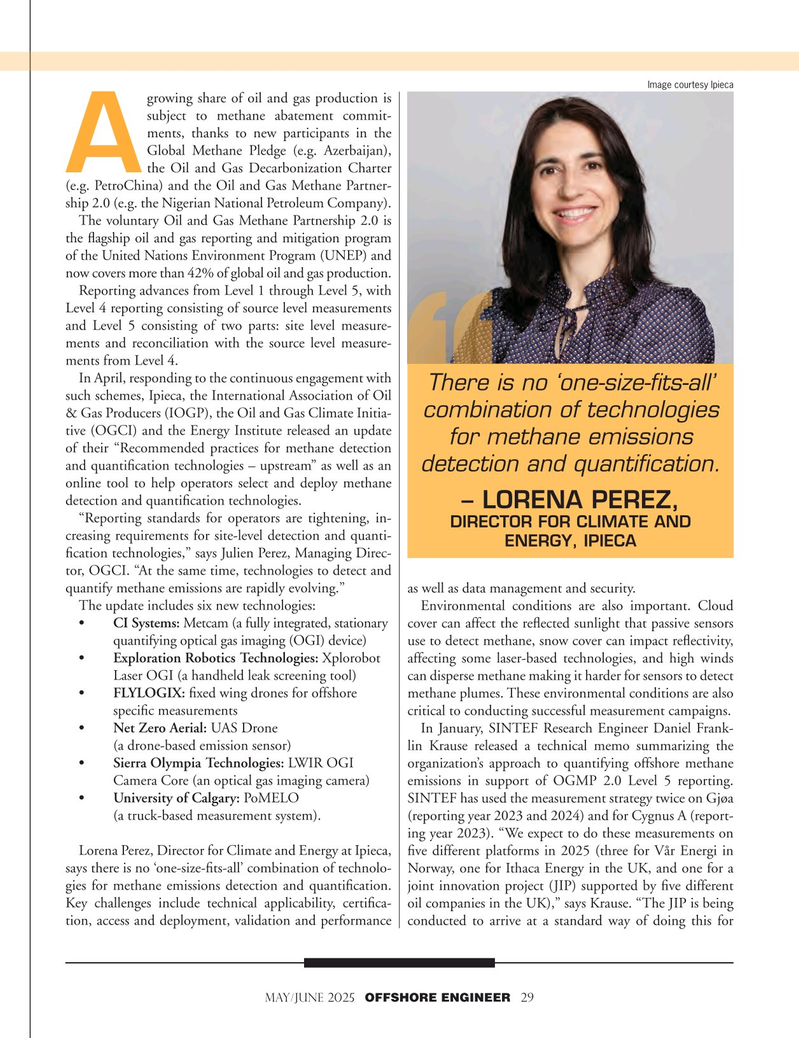
Page 29: of Offshore Engineer Magazine (May/Jun 2025)
Read this page in Pdf, Flash or Html5 edition of May/Jun 2025 Offshore Engineer Magazine
Image courtesy Ipieca growing share of oil and gas production is subject to methane abatement commit- ments, thanks to new participants in the
Global Methane Pledge (e.g. Azerbaijan),
A the Oil and Gas Decarbonization Charter (e.g. PetroChina) and the Oil and Gas Methane Partner- ship 2.0 (e.g. the Nigerian National Petroleum Company).
The voluntary Oil and Gas Methane Partnership 2.0 is the fagship oil and gas reporting and mitigation program of the United Nations Environment Program (UNEP) and now covers more than 42% of global oil and gas production.
Reporting advances from Level 1 through Level 5, with
Level 4 reporting consisting of source level measurements and Level 5 consisting of two parts: site level measure- ments and reconciliation with the source level measure- ments from Level 4.
In April, responding to the continuous engagement with
There is no ‘one-size-fits-all’ such schemes, Ipieca, the International Association of Oil combination of technologies & Gas Producers (IOGP), the Oil and Gas Climate Initia- tive (OGCI) and the Energy Institute released an update for methane emissions of their “Recommended practices for methane detection and quantifcation technologies – upstream” as well as an detection and quantification.
online tool to help operators select and deploy methane detection and quantifcation technologies. – LORENA PEREZ, “Reporting standards for operators are tightening, in-
DIRECTOR FOR CLIMATE AND creasing requirements for site-level detection and quanti-
ENERGY, IPIECA fcation technologies,” says Julien Perez, Managing Direc- tor, OGCI. “At the same time, technologies to detect and quantify methane emissions are rapidly evolving.” as well as data management and security.
The update includes six new technologies: Environmental conditions are also important. Cloud • CI Systems: Metcam (a fully integrated, stationary cover can affect the refected sunlight that passive sensors quantifying optical gas imaging (OGI) device) use to detect methane, snow cover can impact refectivity, • Exploration Robotics Technologies: Xplorobot affecting some laser-based technologies, and high winds Laser OGI (a handheld leak screening tool) can disperse methane making it harder for sensors to detect • FLYLOGIX: fxed wing drones for offshore methane plumes. These environmental conditions are also specifc measurements critical to conducting successful measurement campaigns. • Net Zero Aerial: UAS Drone In January, SINTEF Research Engineer Daniel Frank- (a drone-based emission sensor) lin Krause released a technical memo summarizing the • Sierra Olympia Technologies: LWIR OGI organization’s approach to quantifying offshore methane Camera Core (an optical gas imaging camera) emissions in support of OGMP 2.0 Level 5 reporting. • University of Calgary: PoMELO SINTEF has used the measurement strategy twice on Gjøa (a tr uck-based measurement system). (reporting year 2023 and 2024) and for Cygnus A (report- ing year 2023). “We expect to do these measurements on
Lorena Perez, Director for Climate and Energy at Ipieca, fve different platforms in 2025 (three for Vår Energi in says there is no ‘one-size-fts-all’ combination of technolo- Norway, one for Ithaca Energy in the UK, and one for a gies for methane emissions detection and quantifcation. joint innovation project (JIP) supported by fve different
Key challenges include technical applicability, certifca- oil companies in the UK),” says Krause. “The JIP is being tion, access and deployment, validation and performance conducted to arrive at a standard way of doing this for
MAY/JUNE 2025 OFFSHORE ENGINEER 29

 28
28

 30
30